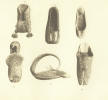
PLATE No. IV.
The South Kensington Museum Collection.
No. 14. Lady’s leather slippers. The uppers and sides are covered with shagreen. The inside of each is partially covered with embroidered shagreen. Cabul. Nineteenth century. Length, 9 inches.
No. 15. Shoes. Of wadded leather, covered with scalloped scales of brass and steel connected by chain-mail. Bhooj, Kuch.
No. 16. Slipper. One of a pair. Embroidered with gold and silver spangles, thread, and tassels, with grelots attached. Indian (Behar). Length, 8 inches.
No. 17. Pair of woman’s shoes, embroidered with gold and silver. Gwalior, Central India.
No. 18. Pair of woman’s shoes, embroidered leather. Gwalior, Central India.
No. 19. Pair of shoes, embroidered leather. Chatterpur, Central India.
Shoes in India are mostly worn by the higher classes and among a few of the lower castes. The habit of going shoeless seems to render the toes of the Hindoo foot almost as lissom as fingers. A blacksmith with a piece of iron to file fixes it between the jaws of a small pair of tongs, grasps them between the toes of both feet, and holds them so firmly that he is able to file with all the strength of his arms. As he works sitting on the ground, he occasionally stretches out a leg, and picks up some article which happens to be beyond the reach of his arm. Such a workman’s foot tends to assume the character of a hand; not only does the great toe become prehensile, but there is an actual enlargement of the distance between it and the other toes. To go barefooted in India must at times be a positive luxury. The higher classes in some parts wear no stockings, only covering their feet with white embroidered slippers. The colour of Oriental shoes appears to be of importance, indicating, it is supposed, the rank and caste of the owner. Red and yellow are the favourite hues, the sole being often red, or black tipped with red. Yellow is the Mohammedan colour.